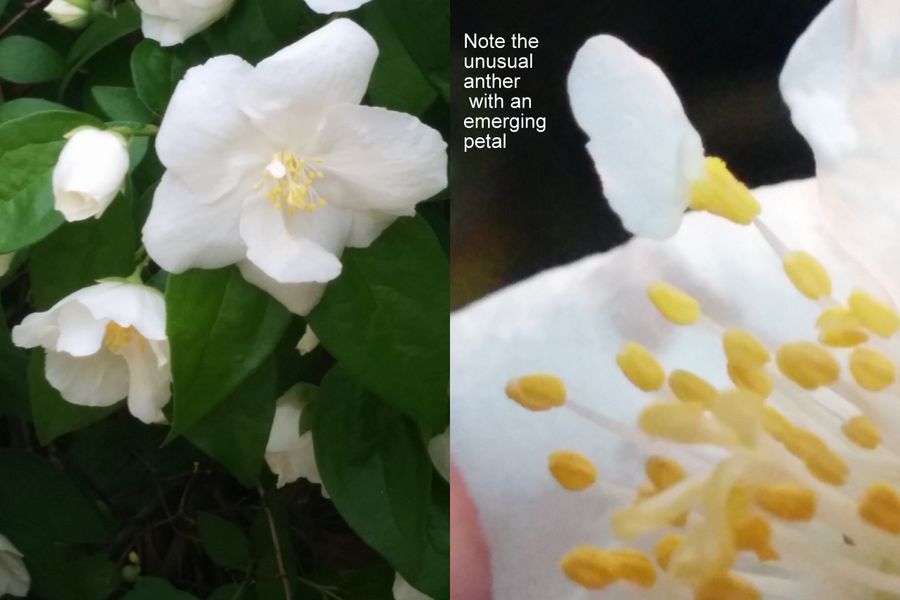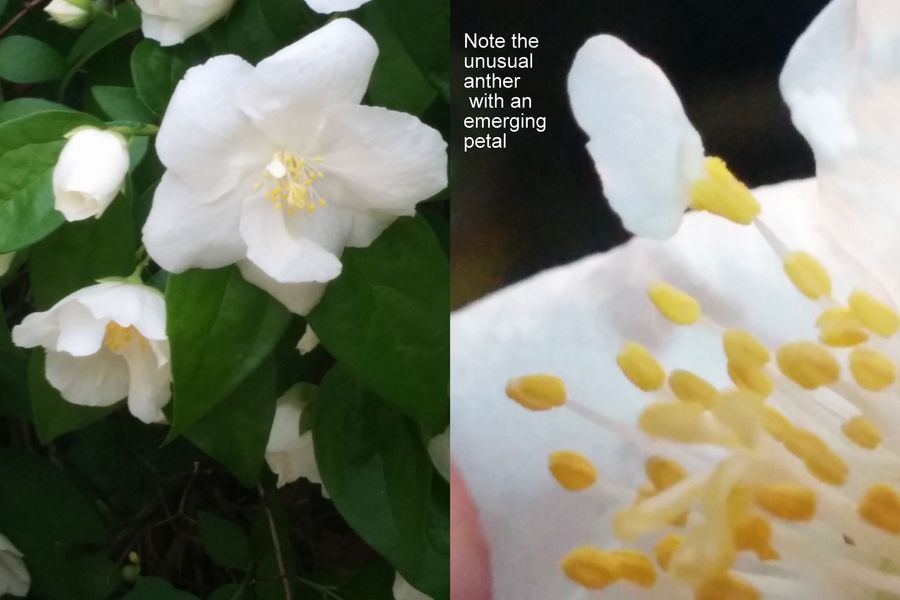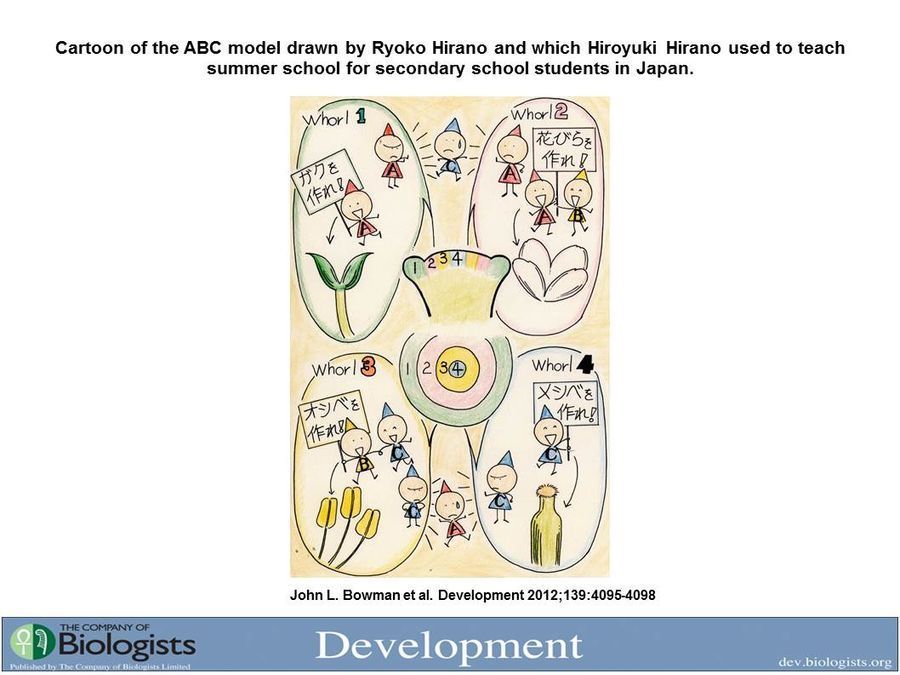The ABCs of flowers
 May 26, 2015 • 8:53 AM UTC
May 26, 2015 • 8:53 AM UTC Unknown Location
Unknown Location 140x Magnification
140x Magnification Microorganisms
Microorganisms
laksiyer
Human observer of life. https://sukshmadarshin.wordpress.com
97posts
1255comments
5locations

The pollen roster project has occupied all my microscopy time, but the journey has opened my eyes to many aspects of plant biology and this post reports one such. A couple of shrubs started blooming in my neighborhood about 2 weeks ago. The flowers were white and looked to be of the Azalea family. I drew near to pluck one when I made a strange observation (Figure 1).

Figure 1
One of the stamens had an unusual anther with a petal emerging from it (Figure 1). I looked around and found this to be common in all flowers in the shrub. I realized that it was a partial homeotic mutation. A homeotic mutation is one where one organ is transformed to another and understanding these mutations has been the bedrock of understanding genes involved in development. I call it partial as there was both a petal and a stamen and the stamen had not completely petalized. The most striking aspect was that of the many stamens only a few (1-3) form such petals in the flowers (see Figure 1). I peered at the stamen under the foldscope to understand the anatomy of the unusual stamen.
One of the stamens had an unusual anther with a petal emerging from it (Figure 1). I looked around and found this to be common in all flowers in the shrub. I realized that it was a partial homeotic mutation. A homeotic mutation is one where one organ is transformed to another and understanding these mutations has been the bedrock of understanding genes involved in development. I call it partial as there was both a petal and a stamen and the stamen had not completely petalized. The most striking aspect was that of the many stamens only a few (1-3) form such petals in the flowers (see Figure 1). I peered at the stamen under the foldscope to understand the anatomy of the unusual stamen.
As you can see in the video above, the filament of the stamen that usually ends in anthers, continues through the anthers to give a petal. It reminded me of the German poet Goethe words “we may equally well say that a stamen is a contracted petal, as that a petal is a stamen in a state of expansion.” It took me back to grad school, some 20 years ago when I heard a wonderful seminar by the great plant developmental biologist Eliot Meyerowitz. A few years earlier, he had proposed the ABC model of floral development that explained floral homeotic mutants and which over the years has become the general model of floral development in the angiosperms . Below I make a feeble attempt to explain the model, but I would strongly recommend you read his very readable works (see references).
Briefly, the flower can be divided into four whorls, corresponding those those that form the sepals, petals, stamen and carpels respectively. When Meyerowitz’s group (and others) studied double and triple homeotic floral mutants they realized that they could categorize the mutants into three groups that they termed A B and C group of genes. These are genes expressed in the primordial flower cells that determine the fate of the organ that they specify. ‘ A ‘ genes only determine sepal formation. ‘ B ‘ group of genes determine both petals and stamens. When B genes combine with A they form petals, whereas when B combine with C they form stamens. Finally the ‘ C’ group of genes determine the carpels. Further, A genes block C genes and vice-versa There is a very nice cartoon that illustrates this in the linked reference that I have attached below.
Briefly, the flower can be divided into four whorls, corresponding those those that form the sepals, petals, stamen and carpels respectively. When Meyerowitz’s group (and others) studied double and triple homeotic floral mutants they realized that they could categorize the mutants into three groups that they termed A B and C group of genes. These are genes expressed in the primordial flower cells that determine the fate of the organ that they specify. ‘ A ‘ genes only determine sepal formation. ‘ B ‘ group of genes determine both petals and stamens. When B genes combine with A they form petals, whereas when B combine with C they form stamens. Finally the ‘ C’ group of genes determine the carpels. Further, A genes block C genes and vice-versa There is a very nice cartoon that illustrates this in the linked reference that I have attached below.

In fact, the Meyerowitz seminar was so memorable because he started playing games with the audience.
1. If an A gene is mutated, the four whorls now become carpel, stamen, stamen, carpel.
2. Mutations in B genes give, sepal, sepal,carpel, carpel.
3. Mutations in C genes give sepal, petal, petal, sepal.
So what does it mean for this flower? Since petals are determined by a combination of A and B group genes and stamens by B and C group genes, the presence of a hybrid organ in what is usually a stamen suggests that there is the leaky expression of the A-class of genes in this stamen. Note that the C and A class of genes inhibit each other. Here I speculate that perhaps a transposon jumped next to an A-class gene resulting in its leaky expression in the stamens, and once the levels of this A gene builds up, the C class of genes are silenced in the stamen and you get a petal. Transposons are notorious for such mosaic expression patterns. Although there could be many other reasons, and I dont think we will ever find out without sequencing or studying the gene expression patterns of this flower.
Finally this mutant reminds me of Darwin’s first chapter in his famous “Origin of species” masterpiece, where he explains how we observe a great variation in domestic species, and how what we breed is driven by human selection based on human fancy/needs. This flower is another such example of a flower variant selected because it pleased some nurseryman.
References .
1 . The ABC model of flower development: then and now. Development. 2012 Nov;139(22):4095-8. doi: 10.1242/dev.083972.
2. The war of the whorls: genetic interactions controlling flower development. Nature. 1991 Sep 5;353(6339):31-7.
1. If an A gene is mutated, the four whorls now become carpel, stamen, stamen, carpel.
2. Mutations in B genes give, sepal, sepal,carpel, carpel.
3. Mutations in C genes give sepal, petal, petal, sepal.
So what does it mean for this flower? Since petals are determined by a combination of A and B group genes and stamens by B and C group genes, the presence of a hybrid organ in what is usually a stamen suggests that there is the leaky expression of the A-class of genes in this stamen. Note that the C and A class of genes inhibit each other. Here I speculate that perhaps a transposon jumped next to an A-class gene resulting in its leaky expression in the stamens, and once the levels of this A gene builds up, the C class of genes are silenced in the stamen and you get a petal. Transposons are notorious for such mosaic expression patterns. Although there could be many other reasons, and I dont think we will ever find out without sequencing or studying the gene expression patterns of this flower.
Finally this mutant reminds me of Darwin’s first chapter in his famous “Origin of species” masterpiece, where he explains how we observe a great variation in domestic species, and how what we breed is driven by human selection based on human fancy/needs. This flower is another such example of a flower variant selected because it pleased some nurseryman.
References .
1 . The ABC model of flower development: then and now. Development. 2012 Nov;139(22):4095-8. doi: 10.1242/dev.083972.
2. The war of the whorls: genetic interactions controlling flower development. Nature. 1991 Sep 5;353(6339):31-7.
Sign in to commentNobody has commented yet... Share your thoughts with the author and start the discussion!

 0 Applause
0 Applause 0 Comments
0 Comments_300x300.jpeg)

















